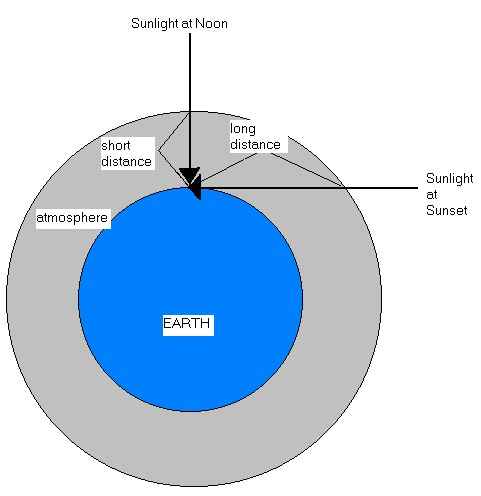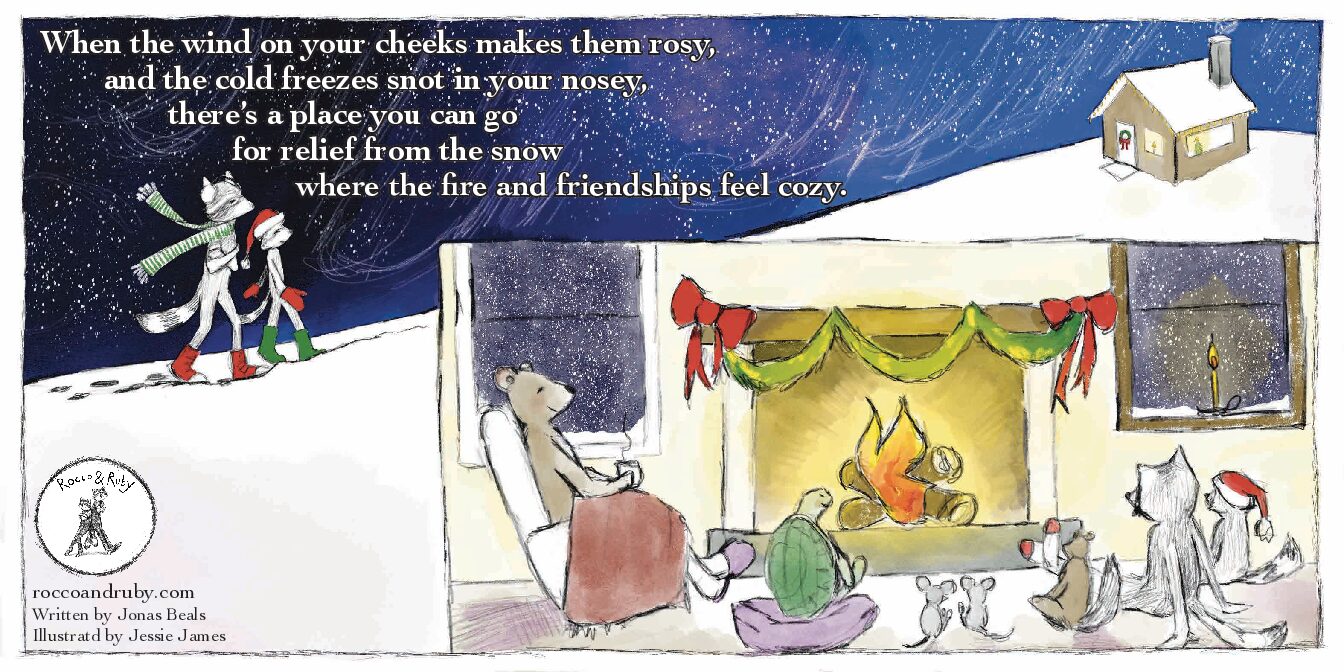
We’ve all seen or at least heard of a blood red moon. But what weather is associated with it? And why does the color fade as the moon rises?
The light from the sun is composed of many types of electromagnetic waves. The human eye can detect only a small portion of these waves, known as the visible spectrum. You may remember the acronym ROYGBIV from earth science classes—Red, Orange, Yellow, Green, Blue, Indigo and Violet. Normally, we see sunlight as white. But when that light is separated into its individual wavelengths, we see the spectrum of colors. Isaac Newton first demonstrated this using a prism. Nature shows us the same effect when a rainbow forms.
Light travels nearly 93 million miles from the sun to Earth. Along the way, it passes through our atmosphere, which contains gases and particles that absorb or scatter light before it reaches our eyes. This scattering process explains why we see different colors. Molecules such as nitrogen and oxygen scatter higher-frequency light most effectively. Our eyes are especially sensitive to blue, which is why the sky looks blue during the day when the sun is high and light passes through a thinner layer of atmosphere.
At sunrise and sunset, however, sunlight must pass through a thicker layer of atmosphere. More scattering occurs, and dust and pollution filter out the higher-frequency light. This leaves us with the longer wavelengths—reds, oranges and yellows. The same is true when the moon is near the horizon because it reflects the sun’s light through that same thick slice of atmosphere. That’s why sunrises, sunsets and moonrises can take on a reddish-orange or even deep blood red hue. The effect is amplified when the atmosphere contains smoke or other aerosols. During the summer of 2025, wildfires in Canada and the western United States created especially vivid red sunsets and moonrises.
Fall and winter often bring the most dramatic red skies because the sun sits at a lower angle in the sky. We typically see the deepest colors in the west, where land-based particles are more abundant compared to the cleaner air over oceans. Clouds can heighten the show, acting as a screen that reflects and scatters the colors of the sun or moon.
For the most intense red moon of all, you need a total lunar eclipse. During an eclipse, the sun’s rays pass through more of Earth’s atmosphere, which enhances the red end of the spectrum. Although our region wasn’t in the right orbit for the most recent total lunar eclipse, the next one is scheduled for March 2–3, 2026.
One final effect makes a rising sun or moon look even more striking: size. When they appear near the horizon, they often seem much larger than when higher in the sky. This illusion occurs because Earth’s atmosphere bends and magnifies light, making them look oversized as they rise.

I grew up an Air Force Brat. Traveled the country and lived in Georgia, Maine, New York, Hawaii and Oklahoma.
I fell in love with the weather in Oklahoma. My father was transferred to Tinker AFB in 1973. While in Temporary housing (a mobile home, which is the standard in Oklahoma) I experienced my first severe thunderstorm with strong winds and hail the size of baseballs. The next day I was in the base library looking up books on weather. The rest is history.
I graduated from the University of Oklahoma in 1983 with a Bachelor’s Degree in Meteorology. The first two years we took Calculus, Differential equations, Physics, Chemistry and Computer science classes with the Engineering Students. It was a grind. My degree is actually from the College of Engineering. The last 2-3 year’s focus was on Meteorology including Observational networks (Satellite, Radar, Surface), Physics, Thermodynamics, Dynamics, Synoptic, Winter Weather, Severe Weather and Climatology.
My first job out of college was with a small forecasting company in Oklahoma City. I was immediately put on TV (OETA) and Radio (WKY) as their broadcast Meteorologist. After two years in broadcasting, I decided to pursue the National Weather Service route and got a position in Toledo, OH as an intern. After a couple of years, I was promoted to a forecaster position at the Cleveland Forecast office. I quickly moved into the Weather Preparedness position and was responsible for all the preparedness activities in the state of Ohio.
In 1992 I decided to pursue other forecast opportunities and moved to the Meteorological Operations Division of the National Meteorological Center in Washington, DC. This group is now called WPC (Weather Prediction Center). There I fine-tuned my forecasting of Synoptic Weather with my focus on Heavy Convective Rainfall and Winter Storms, under the supervision of Dr. Louis Uccellini. He has written several books on East Coast Winter storms. I was promoted to a Senior Branch Forecast position during my tenure at MOD. Part of my job was to teach weather classes at COMET (Cooperative Program for Operational Meteorology, Education, and Training).
In 2012 I was given the opportunity to start up a new weather support group with the FAA (Federal Aviation Administration) in Warrenton, VA at the ATCSSC (Air Traffic Control System Command Center). The ATCSCC is where the FAA identifies solutions to air traffic inefficiencies in the NAS (National Air Space) for the CONUS (Continental United State). Weather impacts are the biggest impact on Aviation with yearly losses over 20 billion dollars. My job was to help lower these inefficiencies/costs by providing weather impact briefings and forecasts in order to keep the air planes moving as safely and efficiently as possible.
I retired in 2022 and now am running Lake Anna Weather, LLC.
Subscribe for Updates
Sponsors
latest articles
Letter from the Editor: Grateful for Our Students

New Rotary Charter Lights Up Patriotism with Flags for Heroes

Lake Anna Region Faces Moderate to Severe Drought

Powering the Lighted Boat Parade: Leaders Behind the Lights

Rocco & Ruby

Travel: Sleep in a Tugboat, Wander to Waterfalls at Lake Glen Haven

We’ve all seen or at least heard of a blood red moon. But what weather is associated with it? And why does the color fade as the moon rises?
The light from the sun is composed of many types of electromagnetic waves. The human eye can detect only a small portion of these waves, known as the visible spectrum. You may remember the acronym ROYGBIV from earth science classes—Red, Orange, Yellow, Green, Blue, Indigo and Violet. Normally, we see sunlight as white. But when that light is separated into its individual wavelengths, we see the spectrum of colors. Isaac Newton first demonstrated this using a prism. Nature shows us the same effect when a rainbow forms.
Light travels nearly 93 million miles from the sun to Earth. Along the way, it passes through our atmosphere, which contains gases and particles that absorb or scatter light before it reaches our eyes. This scattering process explains why we see different colors. Molecules such as nitrogen and oxygen scatter higher-frequency light most effectively. Our eyes are especially sensitive to blue, which is why the sky looks blue during the day when the sun is high and light passes through a thinner layer of atmosphere.
At sunrise and sunset, however, sunlight must pass through a thicker layer of atmosphere. More scattering occurs, and dust and pollution filter out the higher-frequency light. This leaves us with the longer wavelengths—reds, oranges and yellows. The same is true when the moon is near the horizon because it reflects the sun’s light through that same thick slice of atmosphere. That’s why sunrises, sunsets and moonrises can take on a reddish-orange or even deep blood red hue. The effect is amplified when the atmosphere contains smoke or other aerosols. During the summer of 2025, wildfires in Canada and the western United States created especially vivid red sunsets and moonrises.
Fall and winter often bring the most dramatic red skies because the sun sits at a lower angle in the sky. We typically see the deepest colors in the west, where land-based particles are more abundant compared to the cleaner air over oceans. Clouds can heighten the show, acting as a screen that reflects and scatters the colors of the sun or moon.
For the most intense red moon of all, you need a total lunar eclipse. During an eclipse, the sun’s rays pass through more of Earth’s atmosphere, which enhances the red end of the spectrum. Although our region wasn’t in the right orbit for the most recent total lunar eclipse, the next one is scheduled for March 2–3, 2026.
One final effect makes a rising sun or moon look even more striking: size. When they appear near the horizon, they often seem much larger than when higher in the sky. This illusion occurs because Earth’s atmosphere bends and magnifies light, making them look oversized as they rise.

I grew up an Air Force Brat. Traveled the country and lived in Georgia, Maine, New York, Hawaii and Oklahoma.
I fell in love with the weather in Oklahoma. My father was transferred to Tinker AFB in 1973. While in Temporary housing (a mobile home, which is the standard in Oklahoma) I experienced my first severe thunderstorm with strong winds and hail the size of baseballs. The next day I was in the base library looking up books on weather. The rest is history.
I graduated from the University of Oklahoma in 1983 with a Bachelor’s Degree in Meteorology. The first two years we took Calculus, Differential equations, Physics, Chemistry and Computer science classes with the Engineering Students. It was a grind. My degree is actually from the College of Engineering. The last 2-3 year’s focus was on Meteorology including Observational networks (Satellite, Radar, Surface), Physics, Thermodynamics, Dynamics, Synoptic, Winter Weather, Severe Weather and Climatology.
My first job out of college was with a small forecasting company in Oklahoma City. I was immediately put on TV (OETA) and Radio (WKY) as their broadcast Meteorologist. After two years in broadcasting, I decided to pursue the National Weather Service route and got a position in Toledo, OH as an intern. After a couple of years, I was promoted to a forecaster position at the Cleveland Forecast office. I quickly moved into the Weather Preparedness position and was responsible for all the preparedness activities in the state of Ohio.
In 1992 I decided to pursue other forecast opportunities and moved to the Meteorological Operations Division of the National Meteorological Center in Washington, DC. This group is now called WPC (Weather Prediction Center). There I fine-tuned my forecasting of Synoptic Weather with my focus on Heavy Convective Rainfall and Winter Storms, under the supervision of Dr. Louis Uccellini. He has written several books on East Coast Winter storms. I was promoted to a Senior Branch Forecast position during my tenure at MOD. Part of my job was to teach weather classes at COMET (Cooperative Program for Operational Meteorology, Education, and Training).
In 2012 I was given the opportunity to start up a new weather support group with the FAA (Federal Aviation Administration) in Warrenton, VA at the ATCSSC (Air Traffic Control System Command Center). The ATCSCC is where the FAA identifies solutions to air traffic inefficiencies in the NAS (National Air Space) for the CONUS (Continental United State). Weather impacts are the biggest impact on Aviation with yearly losses over 20 billion dollars. My job was to help lower these inefficiencies/costs by providing weather impact briefings and forecasts in order to keep the air planes moving as safely and efficiently as possible.
I retired in 2022 and now am running Lake Anna Weather, LLC.
Subscribe for Updates
Sponsors
latest articles
Letter from the Editor: Grateful for Our Students

New Rotary Charter Lights Up Patriotism with Flags for Heroes

Lake Anna Region Faces Moderate to Severe Drought

Powering the Lighted Boat Parade: Leaders Behind the Lights

Rocco & Ruby

Travel: Sleep in a Tugboat, Wander to Waterfalls at Lake Glen Haven

Spotsylvania Tourism Growth Outpaces Statewide Averages with 35% Surge Since 2019
Article By Jen Bailey
![Featured image for “[Spotsylvania] New Speed Enforcement in School Zones”](https://lakeanna.online/wp-content/uploads/2025/09/Blog-pic-scaled.jpg)
[Spotsylvania] New Speed Enforcement in School Zones
Article By Jen Bailey







